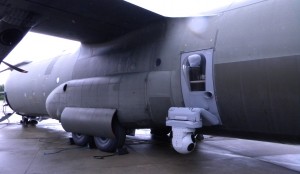From the air, detecting and identifying ground targets, by day or by night, is a strenuous task. Operators must often contend with high workloads, extreme motion, poor atmospheric or ground conditions, pressing time constraints, stress and fatigue.
To assist military operators in these challenging conditions, while also improving Canadian Armed Forces capabilities during search and rescue (SAR) and intelligence, surveillance and reconnaissance (ISR) missions, Defence Research and Development Canada (DRDC) has developed the Advanced Integrated Multi-sensing Surveillance (AIMS) system.
Conceived in 2004, AIMS received flight certification in 2010 and has since accumulated over 50 flight hours on the National Research Council’s DHC-6 Twin Otter. The project has now moved to dry fitment and ground testing, and to a demonstration flight onboard a Royal Canadian Air Force CC-130H Hercules airplane in the summer of 2013. This demonstration integrates AIMS with the Rapid Mount Airborne Sensor System, a parallel DND-sponsored development.
Canadian, eh?
AIMS is the world’s first airborne range-gated active imager integrated into an electro-optical and infrared (EO/IR) multi-sensor stabilized turret. The sensor package includes the near-IR active imager, a thermal imager, wide and narrow field-of-view colour cameras, a laser rangefinder, and a GPS/INS unit.
Funded and led by DRDC, this technology demonstration involves several Canadian companies from across the country such as Obzerv Technologies, L-3 Wescam, CarteNav and Thales Systems Canada, who have worked on various key features of the project.
Active imaging technology
The active imager, as the crown jewel of the sensor suite, consists of a narrow field-of-view, range-gated intensified camera and a near-infrared pulsed laser diode array illuminator.
The laser provides covert illumination, enabling nighttime target illumination. The approach complements thermal imagers and (passive, low resolution) night vision technologies, which require thermal contrast and sufficient ambient light levels, respectively. In absence of thermal contrast and in low-light levels, such as overcast nights or remote operational areas, active imagers figuratively and literally shine by enabling better surveillance.
The AIMS system facilitates surveillance in several ways and is particularly useful to:
• read ship lettering and aircraft wreck call letters at night;
• detect objects based on their relative reflectivity (actively and passively);
• see through windows and windshields at night, which is impossible with thermal imagers;
• detect optical sights;
• detect life-vest retro-reflectors; and
• discriminate individuals carrying weapons.
While the project team has performed preliminary search concepts of operations, comparing imager types and sensor settings, an automated method for sweeping the search area remains to be determined.
To this end, the National Research Council Flight Research Laboratory is leading, in collaboration with DRDC, a three-year project that will analyze the in-flight operation and effectiveness of an electro-optical multi-sensing system in typical SAR missions. In addition to the statistical assessment, the team looks forward to proposing a practicable Contingency Operations Plan.
Complementary imaging sensors, integrated into an operator workstation, offer a solution for operational airborne sensing requirements. The active imager excels at target identification and confirmation, and the thermal imager excels at target search and detection.
When the information is properly collected and displayed to the operator, improved target detection and identification results. With its multi-channel, geo-referenced full motion video, the AIMS system may, ultimately, assist the Canadian Armed Forces with procurement efforts and improve operational capabilities with enhanced situational awareness during SAR and ISR missions.
Dr. Simon Roy is a defence scientist and EO/IR sensor expert in the Tactical Surveillance and Reconnaissance Section at DRDC Valcartier in Quebec. This article was co-authored by Terry Rea, Nicolas Léchevin, Capt. Katherine Likuski and Vincent Larochelle. The authors would like to acknowledge the following Canadian organizations for their contribution to the system development: DAEPM, Aerex Avionique Inc., CAE Professional Services, York University, Ontario Centre of Excellence.
